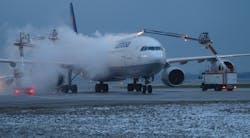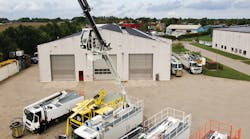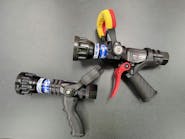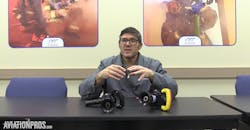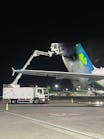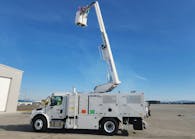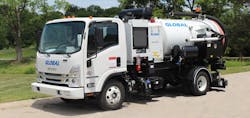Last year, Vestergaard Company added three new, large operations in Germany to its Data Transmission System (DTS) network, proprietary system to easily keep track of aircraft deicing operations. And later this year, the deicing manufacturer will go one better when it outfits operations at an airline’s busy UK hub with the DTS and its Precise Positioning System, which safely takes the guess work out of keeping a safe distance from aircraft while still performing an efficient deicing.
DTS
Last year, N*ICE, the Fraport-owned deicing operator at Frankfurt Airport, fitted all its 58 Vestergaard Elephant® units with DTS.
The aviation industry requires more and more documentation for all safety related actions. This certainly also applies to de-icing/anti-icing operations.
For 25 years, Vestergaard has offered the Data Transmission System tracking data related to deicing operations such as time, aircraft, location, fluid consumption, fluid temperatures, weather, operator, refractive index values, and truck performance. Most new vehicles are now sold with this system.
The DTS records, documents and processes information on deicing/anti-icing performance. At its most basic, the DTS records fluid selection and consumption, and can print the information out on a printer mounted inside the operator’s cab. However, the truck itself can be linked wirelessly to a central computer by cell phone.
“The DTS logs information about deicing operations so the operator doesn’t have to spend time making these notes in a log book between the deicing sessions,” says Rasmus Jakobsen, IT engineering manager for Vestergaard. “This saves time, so the operator can go straight to the next deicing operation. Both the deicing unit and the deicing pad are better utilized. Ultimately this optimization could remove the need for an additional deicing pad.”
The operator’s panel is located in either the spray cabin or the truck cabin. It consists of a touch-screen interface, enabling the operators to record data other than deicing operations, such as aircraft register number; flight number, etc.
All data is conveniently backed up and stored on a Vestergaard server.
”The company’s administration also saves time since they don’t have to manually process all the deicing jobs,” Jakobsen adds. “It is also a clear benefit from the DTS that they have access to statistics from the operations.”
In addition the DTS system can be expanded with modules enabling the deicing coordinator to use the system for unit allocation purposes, and/or to feed the system with information from the airport dispatch system.
At the time that the job at FRA was nearly completed, British Airways was in the process of fitting its 24 units with DTS, and AéroMAG 2000/United Airlines at Newark Liberty International Airport was also expecting delivering of the DTS for 10 deicers.
PPS
Meanwhile, British Airways is readying a fleet of 10 new Elephant Beta NG deicers for this year’s winter operations at its UK hub at Heathrow Airport. The new vehicles not only include the DTS, but also Vestergaard's Precise Positioning System (PPS) safety system.
The company only introduced the PPS at the 2013 interairport show in Munich.
The patented system’s technology, based on proximity sensor measurement, allows operators to consistently ensure that the nozzle is kept within 1 meter (a little more than 3 feet) from the aircraft’s surface. As a result, the heated deicing fluid will lose keep that much more of its heat to treat the aircraft.
“We believe this new technology will really help operators on their task,” says Lars Barsoe, sales manager for Vestergaard, “and it will probably mean they will tire less since there is on less thing to worry about in the deicing process.”
The company figures the PPS is a natural with the Beta NG’s 12-meter long telescopic boom. The nozzle's maneuverability allows backwards spaying towards the operator, enabling wing deicing from the trailing edge of the wing without spraying towards the flaps and rudders.
